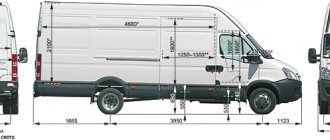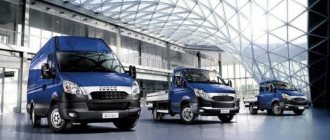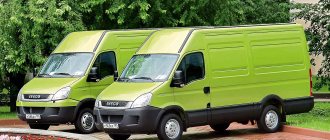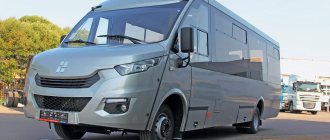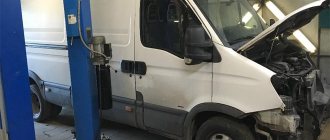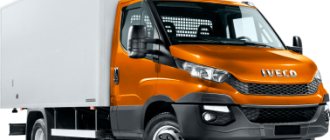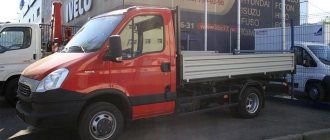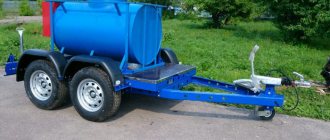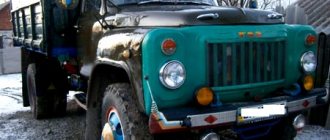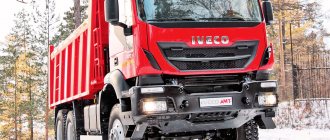Commercial van manufactured by Iveco
| Iveco Daily | |
| Review | |
| Manufacturer | Iveco |
| Also called | Iveco EcoDaily First generation only : Fiat Daily (until 1983) OM Grint Alfa Romeo AR8 Zastava Rival Irisbus EcoDaily |
| Production | 1978–present |
| assembly | Suzzara, Mantua, Italy Valladolid, Spain Boumerdes, Algeria (IVAL)[1] Nanjing, China |
| Designer | Luan Hasney (first generation) |
| Body and chassis | |
| Class | Light commercial vehicle/van () |
| Body type | Van Minibus Pickup |
| Chronology | |
| Predecessor |
|
| Successor | Fiat Ducato (for Fiat Daily and other first generation rebadges) |
In Iveco Daily
large light advertising van produced by Italian automaker Iveco since 1978;
it was also sold as Fiat Daily
to Fiat until 1983.
Unlike the more automotive unibody Fiat Ducato, the Daily uses a separate ladder frame typical of heavier commercial vehicles. Iveco Daily is produced at the Iveco Suzzara plant, near Mantua in Italy, where Iveco recently[ when?
] have invested heavily in upgrading their production lines.
The Daily is also the longest-lasting car produced by Iveco, with over 3 million units sold in over 40 years. Today it is sold in 110 markets worldwide.[2]
Content
- 1 First generation (1978–1992) 1.1 Engines[6]
- 2.1 Engines
- 3.1 Engines
- 4.1 Engines
- 5.1 Iveco Daily Ocean
- 6.1 Engines
Cabin
Models have a modern interior starting from 2006. The cabin is dominated by calm gray tones, helping to concentrate on the road. The driver's seat of the Iveco Daily is spacious. There is a lot of free space under your feet, as well as above your head. The chair has a comfortable shape that flows around the body. It is adjustable in height and in the longitudinal direction. Instances of the fifth and sixth generations have comfortable armrests.
The front panel of cars produced in 2006-2011 has similar features. Here the main controls are effectively highlighted in red. The instrument panel is replenished with sensors - this includes a tachometer, speedometer, oil pressure and engine temperature sensors, and a digital fault panel. At the same time, it does not look cluttered - everything is in its place.
The sixth generation Iveco Daly cars have a radically different front panel. Here, smooth round shapes are replaced by streamlined rectangular elements. Elongated niches for storing small items have appeared throughout the cabin, and in the center there is a convenient holder for a tablet. Some of the buttons have been moved and are now located on the steering wheel. Overall, the new interior design looks a little elongated, but it does not lack streamlined lines.
First generation (1978–1992)
Iveco Daily first generation.
Alfa Romeo AR8 The first Daily series was offered with two models, 35 and 50 (3.5 and 5.0 tons). The larger one (Daily 50) had a carrying capacity of up to 17 m³. In 1985, a turbodiesel version was introduced called "TurboDaily".[3] Alfa Romeo badge designed version was sold as Alfa Romeo AR8
, similar to the AR6-based Fiat Ducato.
The OM version was originally called the OM Grint
, and later the turbocharged version
OM TurboGrinta
.[4] In Switzerland they were also sold as Saurer-Fiat and as Saurer-OM.[5]
Engines[6]
- 2.5 l diesel 72 hp (54 kW) at 4200 rpm, 141 N⋅m (104 lb⋅ft) at 2400 rpm
- 2.5 l turbodiesel 95 hp (71 kW) at 4,100 rpm, 217 N⋅m (160 lb⋅ft) at 2,300 rpm
- 2.5l diesel ID 75 hp (56 kW) at 4200 rpm, 160 N⋅m (118 lb⋅ft) at 2200 rpm (Zastava Rival only)
Price
The cost of cars depends on the modification and purpose of a particular model. There are specimens in several price categories:
- trucks with flatbed bodies – from 2.4 million;
- van with isothermal equipment – from 2.5 million;
- all-metal van - from 2.2 million;
- van for transporting manufactured goods – from 2.4 million.
The Daily auto platform itself, without additional equipment, can be purchased for 2.1 million rubles. All prices are presented in Russian rubles and for models in basic configurations. For an additional fee you can:
- transform the interior and make it in a two-tone color scheme;
- install additional gas equipment;
- add the vehicle to the Daily Business Up transportation management system;
- equip the suspension with a torsion bar stiffness adjuster;
- increase the volume of the cargo compartment to 17.2 m3.
By installing an additional equipment package, the cost of Iveco Daily can increase to 3-3.4 million rubles.
Second generation (1990–2000)
Iveco TurboDaily second generation Iveco Daily second generation rear
The second generation Daily was introduced in 1990 with a completely redesigned taxi and improvements to the Sophim engine (at that time 2.5 l). Following Ford's entry into the Iveco business in 1986, the Daily 3.5 ton was soon removed from the UK market as it was now in direct competition with the Ford Transit, the Daily remained in the UK with a power rating above 4.0 ton and is now on sale. like Iveco-Ford Truck. Daily has no other affiliation with Transit. Turbodiesel versions are called "TurboDaily".
The second generation was modernized in 1996; Externally it differs only slightly, but a 2.8-liter engine with 76 kW (103 hp) is now available. Models 59-12 (chassis cabs and vans) and 59-13 (minibuses) with a gross weight of 6.4 tons were launched. All-wheel drive options were also available.
Carabinieri Van Iveco Daily 4X4.
Engines
- Diesel 2.5 liters with a power of 75 hp. (56 kW) at 4200 rpm
- Turbodiesel 2.5 l, 103 hp. (77 kW) at 3800 rpm
- 2.5 l TDI 116 hp (87 kW) at 3800 rpm
- 2.8 l diesel 85 hp (63 kW)
- Turbodiesel 2.8 l, 103 hp. (77 kW) at 3600 rpm
- 2.8 l TDI 122 hp (91 kW) at 3600 rpm
Chinese production
Since 1997, Daily has been manufactured under license in China by Nanjing Automobile, a subsidiary of Naveco.
.
Iveco today
Today Iveco is recognized as one of the most influential modern suppliers and distributors of trucks, fire trucks and other industrial special equipment. The transnational association has existing and long-term contracts with leading automotive companies from all over the world.
The company has more than fifty factories and plants located in different parts of the world.
In addition, Iveco does not stop there and continues to increase its intellectual potential - in total, the brand has fifteen research centers employing the best specialists of our time.
The main corporate values of the company are the preservation of the specialization of the different branches of Iveco, as well as the transmission and continuity of values, experience and traditions.
Today, the company produces trucks belonging to different market segments, components for them, car engines, special industrial and commercial vehicles, passenger buses and some special equipment. All offered products are distinguished by high quality, as well as up-to-date modern technical characteristics.
According to the latest statistics:
- Every year the company sells over 160 thousand vehicles and about 430 thousand engines;
- Financial income exceeds the mark of 9000000000 euros;
- In total, Iveco has 844 dealerships employing approximately 32 thousand employees;
- In Argentina, Russia, Korea, Libya, Kazakhstan, Turkey, China and a number of other countries, a licensed process for assembling cars and trucks has already been established;
- Iveco ranks 6th in the global ranking of companies specializing in the production of commercial and industrial trucks;
- Iveco ranks 2nd in the world ranking in terms of engine sales volumes.
Third generation (2000–2006)
Third generation Daily as minibus Daily Van third generation Rear van Daily third generation.
With the third series, Daily was replenished with new light groups (wider and lower). The Turbodaily name was dropped as all turbodiesels were equipped with Unijet (Common Rail) technology. Two new versions were released: "Agile" with automatic gear shifting and "CNG". natural gas version. Two new load classes were also introduced: Daily 65 and Daily 28 (6.5 tons and 2.8 tons). Iveco Daily was voted "Van of the Year" 2000.
The third generation Iveco Daily and the second generation Renault Mascott share many panels and some cabin components, including doors, by agreement between Iveco and Renault in July 1994. The agreement provided for the production and sharing of common components in a total of 120 thousand units per year, produced at various plants in Brescia (Italy, Iveco), Suzzara (Italy, Iveco), Valladolid (Spain). , Iveco) and Batilly (France, SoVAB Renault Plant).[7]
Engines
Initially there were models with three engine options, all 2.8 liter 8140. A 66 kW (90 hp) suction diesel was an option, but these were rarely sold. The other had a turbocharger, intercooler and 78 kW (106 hp). The latter variant produced 92 kW (125 hp) and had a battery fuel injection system. The engine soon received the largest variable geometry turbocharger with an output of 107 kW (146 hp).
In 2003, the F1A engine appeared with a displacement of 2.3 liters and a second generation common rail injection system with power of 74 kW (101 hp) and 88 kW (120 hp), and in 2004 a new F1C engine with a displacement of 3.0 liter based on F1A with timing chain. and 100 kW (136 hp) or 122 kW (166 hp). At this time the old 8140 engine was completely replaced.
Transmissions
Engines up to 88 kW (120 hp) had a five-speed gearbox, and more powerful engines were also offered with a six-speed gearbox. The model could also be obtained with an electronic/hydraulic controlled manual transmission called Flexible
.
Best the enemy of the good
The first modernization of the IVECO Daily was carried out in 1989. The design of the cabins was updated, the power unit and transmission were replaced with more advanced ones, in particular, a new 116-horsepower diesel engine with direct injection and turbocharging, supplemented by an intercooler, appeared, and the number of modifications offered to customers reached hundreds . The new engines, created based on the modernization of the Sofim 8140 diesel engine, were distinguished by a 15% reduction in fuel consumption and did not require serious repairs until the mileage was 700 thousand km. In 1991, production of IVECO Daily was established even in China.
1998 was a year of record sales for the IVECO Daily family. Worldwide, 75 thousand light-duty trucks and buses were sold, which far exceeded the result of its closest competitors. IVECO Daily's share of the light truck segment on the European continent was 18%, with demand for vehicles steadily increasing. In 1999, IVECO management decided to start producing them in Spain.
Fourth generation (2006–2011)
Fourth generation Daily van Fourth generation Daily van rear
The fourth generation was designed by Giugiaro and arrived on the market in mid-2006. It is available as: van, cabin cruiser, combi, minibus, flex and CNG. The minibus is also commercialized with the Irisbus brand. Some models with environmentally friendly engines were sold as "Iveco EcoDaily" in some European markets.[8]
For the first time since 2000, an all-wheel drive version of the Daily is available in 2007. It was developed jointly with the company. FRAUD and is available in both single and double cab with wheelbases of 3,050 mm (120 in) and 3,400 mm (130 in) and double cab with wheelbase 3,400 mm (130 in). Permissible total weight in two versions: 3500 kg (7700 lb) or 5500 kg (12100 lb).
Engines
- 2.3 hp 96 hp (71 kW; 95 hp) and 116 hp (85 kW; 114 hp)
- 2.3 hp 90 hp (66 kW; 89 hp) diesel
- 3.0 hp / 146 hp (107 kW; 144 hp)
- 3.0 hp 176 hp (129 kW; 174 hp)
- 3.0 CNG 136 metric power (100 kW)
Fifth generation (2011–2014)
| Iveco Daily | |
| Review | |
| Manufacturer | Iveco |
| Production | 2011-2014 2017-present (Iveco Daily Ousheng) |
| Body and chassis | |
| Class | Light commercial vehicle () |
| Body type | Van Minibus Pickup |
| Transmission | |
| Engine | 2.3 diesel 3.0 diesel |
| Transmission of infection | 6-speed manual 6-speed semi-automatic[9] |
The fifth generation was introduced on June 29, 2011 and hit the market in early September 2011.[10]
Iveco Daily Ocean
Naveco (Nanjing Iveco) Daily Ousheng Tourist RV
The version released by Naveco (Nanjing Iveco) China is called Iveco Daily Ousheng
(欧胜) was a facelift based on the fifth generation Iveco Daily,[11] and expanded production from 2022.[12]
Engines
Euro 5
- 2.3 L 78 kW (106 hp) / 270 Nm
- 2.3 l 93 kW (126 hp) / 320 Nm
- 2.3 L 107 kW (146 hp) / 350 Nm
- 3.0 L 107 kW (146 hp) / 350 Nm
- 3.0 L 126 kW (170 hp) / 400 Nm
- 3.0 L 150 kW (205 hp) / 470 Nm
EEV
- 3.0 L 107 kW (146 hp) / 370 Nm
- 3.0 L 126 kW (170 hp) / 400 Nm
- 3.0 L CNG 100 kW (136 hp) / 350 Nm[13]
Features of operation
Cars delight car owners with their durability and resistance to overloads. However, to ensure that the car lasts as long as possible, you should adhere to basic operating rules. This includes timely visits to service centers and the use of original spare parts and high-quality fuels and lubricants.
During operation, special attention should be paid to the dual-mass flywheel, which quickly wears out during long runs at low speeds and frequent starts and stops of the Iveco Daly engine. Also, you should not allow oil to get on the timing chain - it washes away the grease and the chain begins to jam. All other elements, with careful use, do not cause any complaints. Unless you should pay attention to the rear axle, in which the breather often breaks down.
Company representatives are reliable and hardy business assistants. A high level of safety combined with resistance to overloads allowed them to gain popularity among car enthusiasts. When choosing Iveco Daily, you can rest assured that your purchase will be successful.
Sixth generation (2014–present)
| Iveco Daily | |
| Review | |
| Manufacturer | Iveco |
| Production | 2014-present |
| Body and chassis | |
| Class | Light commercial vehicle () |
| Body type | Van Minibus Pickup |
| Transmission | |
| Engine | 2.3 JTD 3.0 JTD and CNG |
| Transmission of infection | 6-speed manual 6-speed semi-automatic 8-speed ZF 8HP automatic |
| Dimensions | |
| Wheelbase | 3000-3950 mm |
Iveco Daily Hi-Matic 2.3 rear
The sixth generation was introduced in July 2014.
Engines
Euro 5
- 2.3 L 78 kW (106 hp) / 270 Nm
- 2.3 l 93 kW (126 hp) / 320 Nm
- 2.3 L 107 kW (146 hp) / 350 Nm
- 3.0 L 107 kW (146 hp) / 350 Nm
- 3.0 L 126 kW (170 hp) / 400 Nm
- 3.0 L 150 kW (205 hp) / 470 Nm
Euro 6
- 3.0 L 107 kW (146 hp) / 370 Nm
- 3.0 L 126 kW (170 hp) / 400 Nm
- 3.0 L CNG 100 kW (136 hp) / 350 Nm[14]
Recommendations
- https://www.autobip.com/actualite_auto/usine_iveco_algerie_debut_de_production_de_commercialisation_des_vehicules/4968 Missing or empty | title = (help)
- "Iveco Daily celebrates 40 years of success." Iveco. July 20, 2022. Retrieved January 4, 2022.
- "Vieni, c'è una casa tutta da guidare nell'anno che verrà." La Repubblica. September 8, 1984. Retrieved January 9, 2022.
- “Nozze europe tra Iveco e Ford.” La Repubblica. December 31, 1985. Retrieved January 9, 2022.
- Rohrbach, Hans W., ed. (1982), Internationaler Nutzfahrzeug-Katalog (Inufa) 1982
[
International Commercial Vehicle Catalog
] (in German),
24
, Solothurn, Switzerland: Vogt-Schild AG, p. 214 - Dusko, Terzic; Nestorovich, Emilia; Traveler, Svetozar; Kachar, Sasha; Jovicic, Vladimir; Janic, Ana; Ristic, Milko (3 May 2022). “Hirurško liječenje infkcije sa apscesnom formacijom izlaznog mjesta kabla za napajanje ureaja za potporu rada ljeve komore.” Scripta Medica
.
49
(1):57–60. Doi:10.18575/msrs.sm.s.18.09. ISSN 2303-7954. - "Joint cooperation with Iveco (Fiat) and Renault." La Repubblica. July 26, 1994. Retrieved January 9, 2022.
- "Iveco EcoDaily". Whatvan. Retrieved March 22, 2013.
- "Nuovo furgone Iveco Daily". Iveco.com. Retrieved May 30, 2017.
- “New Daily is a new hero for transport professionals.” web.iveco.com
. Retrieved September 24, 2011. - "南京依维柯 - 依维柯 Daily (欧胜)."
- "推三种车型依维柯 Daily 11 月 4 日上市."
- "Performance ed efficienza - Iveco Daily furgone." Iveco.com. Retrieved May 30, 2022.
- https://www.iveco.com/Italy/collections/catalogues/Documents/New-Daily/Cat-Daily-Van-IT.pdf
- "ECODAL Electric Motor". Materials for sale
. Iveco UK. 2010. Retrieved July 18, 2010.
